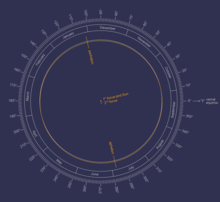

Earth orbits the Sun at an average distance of 149.60 million km (92.96 million mi), or 8.317 light-minutes,[1] in a counterclockwise direction as viewed from above the Northern Hemisphere. One complete orbit takes 365.256 days (1 sidereal year), during which time Earth has traveled 940 million km (584 million mi).[2] Ignoring the influence of other Solar System bodies, Earth's orbit, also called Earth's revolution, is an ellipse with the Earth–Sun barycenter as one focus with a current eccentricity of 0.0167. Since this value is close to zero, the center of the orbit is relatively close to the center of the Sun (relative to the size of the orbit).
As seen from Earth, the planet's orbital prograde motion makes the Sun appear to move with respect to other stars at a rate of about 1° eastward per solar day (or a Sun or Moon diameter every 12 hours).[nb 1] Earth's orbital speed averages 29.78 km/s (19 mi/s; 107,208 km/h; 66,616 mph), which is fast enough to cover the planet's diameter in 7 minutes and the distance to the Moon in 4 hours.[3] The point towards which the Earth in its solar orbit is directed at any given instant is known as the "apex of the Earth's way".[4][5]
From a vantage point above the north pole of either the Sun or Earth, Earth would appear to revolve in a counterclockwise direction around the Sun. From the same vantage point, both the Earth and the Sun would appear to rotate also in a counterclockwise direction about their respective axes.
- ^ "Sun: Facts & Figures". Solar System Exploration. National Aeronautics and Space Administration. Archived from the original on July 3, 2015. Retrieved July 29, 2015.
- ^ Jean Meeus, Astronomical Algorithms 2nd ed, ISBN 0-943396-61-1 (Richmond, VA: Willmann-Bell, 1998) 238. See Ellipse#Circumference. The formula by Ramanujan is accurate enough.[citation needed]
- ^ Williams, David R. (1 September 2004). "Earth Fact Sheet". NASA. Retrieved 17 March 2007.
- ^ "1893PA......1..373S Page 373". articles.adsabs.harvard.edu.
- ^ "Apex". Tidjma.tn.
Cite error: There are <ref group=nb> tags on this page, but the references will not show without a {{reflist|group=nb}} template (see the help page).